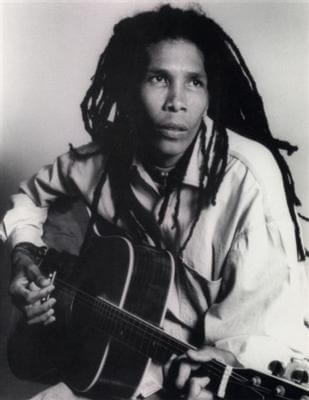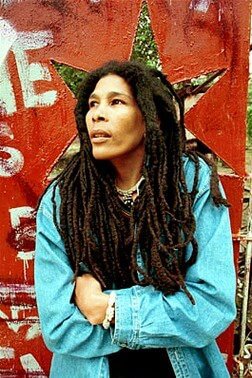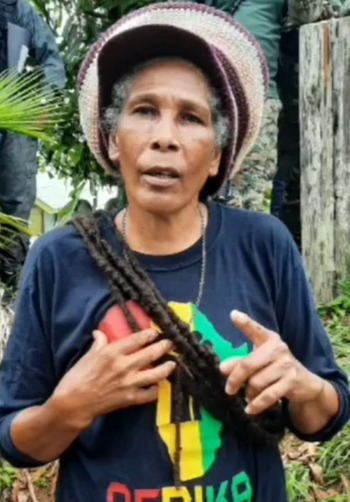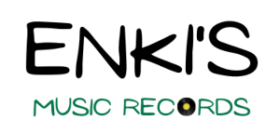Discover Nasio Fontaine’s biography in his own words! The following is an extract of Nasio’s interview that ran in The Beat in the December 2003 issue.
Scroll down for a shorter biography, and to discover where Nasio Fontaine is now.
“I was born in Bagatelle/Carte-Bois, a little village on the South-eastern coast of Dominica. The island was named by the Caribs Whittikibuli, that is the original name for the island, until Chris-thief a Crumble-us [Christopher Columbus] came and named it Dominica. I ‘n I was raised by a Carib mother and an African-descent father who are my mentors, they have grown me into who I ‘n I am today. They are my best friends. Their strength and love has been with me throughout my life and I love them”.
“I was brought up in a little old country house, a little one room country shack. I look at myself as old as yesterday and as young as tomorrow. I am the last of seven children – three sons and four daughters. We went to school from the age of five, but we never had the opportunity to go to so called secondary or high school. So when we were 14 we had to leave school because there was just no other way. We’d then be farming with our parents so that we could feed the family, y’understand?”
Nasio continued by telling of his musical influences and when he originally got into music.

“Well, anyone from the Village would tell you that I started making noise very young. I would pound on everything. Those milk tins, ya know, milk pans, and my sisters would hide them but I’d always get them back. I would even get beat at school by teachers because I was always pounding on my desks. Ya see, that vibe was always inside of me, and I’ve always wanted to express it. I’ve always felt like music was the only vehicle that would be available to me.
And growing up I never really listened to Reggae. I grew up listening to Calypso and to Soul. Like Otis Redding, Sam Cooke, Curtis Mayfield, Marvin Gaye and others. We had a little Phillips radio about one foot long and six inches high and that used to be the pride of the family. All that time I never knew about Reggae. See, we were brought up in a country with no electricity and no bathrooms and no running water and we had to use kerosene lamps and do homework by candlelight. I didn’t really know what was out there. I had a very humble upbringing and that was the greatest part of my life, because it set me into that zone where I was properly brought up. Not on material things, but on the true essence of life.”
In 1981, Nasio made a decision which would alter his life forever. He decided to migrate to St. Maarten.
“St. Maarten is like an hour and one half flight away from Dominica. My brothers and sisters had been inviting me to come all the time. I didn’t really want to ’cause I was the last kid, ya know? Home was my haven, but Mommy said ‘yeah, you should go and see what’s happening.
“So I left, and in 1981 Rastafari became a part of me. See, every man has work to do and every man must find a way to fulfill his work, to benefit mankind. So I was learning Reggae then, but I never really like to listen to other people’s music. I’ve always wanted them to listen to mine. So one night I was allowed to sing one tune and everybody said that I gotta keep on singing! Ya know, I remember singing back in Dominica, back in school talent shows and church choirs. And I remember winning my first competition. I won a ruler, a pack of books, a pack of pencils and a pack of crayons. That was nice, ’cause Mother and Daddy didn’t have to struggle to get the money to buy those things. Then from that time [1981], I started to work odd jobs. In supermarkets, on piers, cleaning yachts and I was always saving my money. Then it happened that in 1986 I decided to go to the recording studio to do my first record ever. You have to remember that I didn’t know anything about it, ’cause the place where I came from, it’s impossible. If you tell anybody you were gonna do a record, it’s like you’re mad – this just cannot happen. But I got it done. On my own with no promoter, with no producer, with nobody. Just saved my money and got it done.”

That ultimately became his first single, “Born To Be Free,” which was the song that got everything started.
“Yes, that song everyone in the ghetto loved, and from there it got played in the Caribbean. The song itself was written as a protest against apartheid. Then in 1990 I went back to the studio with what little money I made from “Born To Be Free” to record “Babylon Is A Fallin.” And “Babylon Is A Fallin” made another positive impact and started receiving more international airplay. Then in 1992 I decided to record a full album [“Reggae Power”] but this time I went to Mixing Lab Studios in Jamaica. I hired some great musicians like Carl Ayton, Dwight Pickney, Gibby Morrison, Robby Lyn, Keith Sterling and Hopeton Hibbert, with backing vocals done by Melanie and Leba Hibbert and Sharon Tucker and they all treated me as a brother.”
“The thing about “Reggae Power” though, was to tell ya the truth, I went back with the tape to St. Maarten, but I had no money to press the music. So I kept the tape for two years in my house before it was released in ’94, just figuring out how I’m gonna get the money together to press it. One time, it cross my mind that I shouldn’t release the songs anymore. I felt the time of the music had passed. Then one day I was playing the tape for a good friend of mine and he was going like “who’s that?” and I told him it was me. He then said, “look man, look some money, press the music!” So I went to the US – to Discmakers – and pressed 2000 CDs. And bro, like God is my witness, from there the rest is just history, man. It was really something.”
From that crucial debut up through his latest masterpiece, Nasio has stayed true to his roots.
“Well I ‘n I stands roots, I ‘n I born among roots and my music is what I feel,” stated Nasio. “When I need to express myself I do it through Reggae. Reggae is what we use to inform I ‘n I worldwide. I ‘n I inspiration come from the powers of His Imperial Majesty, Emperor Haile I Selassie I, Jah Rastafari, and that manifest itself through all things and people and when it filter through I ‘n I, it pours out in the form of reggae music.
“Music communicates to all people but it can especially connect to be the voice of the oppressed and downtrodden and to them it becomes the voice for the voiceless. See, my music is a music that will uplift people all through the world. People need conscious music inna rootical musical style. It is easier for them to understand the message through that particular style of riddem. For me, the purpose of the music is that it can comfort the people. It can uplift them and guide them through all of life’s struggles, trials and tribulations. It can take my people and teach them and show them and make them overstand where they’re going, where they’re coming from and where them heading.”
Nasio’s lyrics truly do teach and even though he didn’t have formal schooling after the age of 14, he still has continued to write some of the most intelligent, concise and evocative songs around.
“Well you see, growing up me never know about Bob,” stated Nasio. “The same year I came to St. Maarten is the same year that Bob died. Then I heard Bob say things – things that I would have said in my life. Like “Africa Unite,” “Rastaman Vibration” and Get Up and fight for your rights. I go, wow, these are things that I’d like to say, so it just made me love Bob, but ya know, Bob Marley is Bob Marley and Nasio Fontaine is Nasio Fontaine. That’s all I can really say about that. Bob Marley is a great voice to humanity and the whole Earth love Bob, yes I. Rasta is the king of reggae music. Him is an inspiration to me like he is to billions.”
In 1995, the outstanding video, “Wanna Go Home” (the closing tune on ‘Reggae Power’) was released and it was said to be the first time that filming was allowed at a Grounation (an important Rastafari holy day).
“Yes,” said Nasio, “we went back to Jamaica and filmed the video from 7 o’clock inna the nite til 7 o’clock inna the morning. We went to the Tabanacle – which is Rastafari’s holy ground. It’s like the Ark of the Covenant, ya know? Holy place. I told the elders that I wasn’t there to make money out of nyabinghi, ’cause I ‘n I is a rastaman but I come there to take nyabinghi and bring it to the rest of the Earth so that people could see that Rastafari is a force in the Earth. And that night, lightning flashed and thunder rolled, man, and it rained for about 45 minutes. I tell you, the spirit was burning! It was a great opportunity for us getting the wisdom of the elders and we would love to thank the Scots Pass Nyabinghi Order for allowing us to film the “Wanna Go Home” video. Ras Tafari Liveth.”
[ You can find the unedited, complete version of the interview here]
Short biography of Nasio Fontaine
Nasio Fontaine was born in 1969, the youngest of seven children born to a Carib mother and father of African descent, in the village of Carte-Bois (Dominica). When he was eight years old, Nasio began singing in the Bagatelle school and the village Catholic church choirs.
In 1981, Fontaine migrated to St. Martin where he became influenced by Rastafari and reggae artists such as Burning Spear, Jacob Miller, and Bob Marley, to whom he is often compared.

Nasio worked for five years to finance his first recordings, his first sessions resulted in the singer’s debut, ‘Born To Be Free’ in 1986 that proved a hit throughout the Caribbean. It sold over 5,000 copies in St. Maarten, the island’s biggest ever selling single. Nasio followed it with the EP ‘Babylon is Falling’ in 1990.
The album ‘Reggae Power’ was released in 1994 and led to a US promotional tour where Fontaine signed with Aphelion Productions Inc. The partnership led to the album’s re-release, and it was selected as Best Reggae Album in 1996 by Reggae Roots International Magazine. He was recognised as Best New Artist by Gavin Magazine, and received nominations from the Tamika Reggae Awards and The Canadian Reggae Music Awards.
Fontaine also enjoyed acclaim for the promo-video that accompanied ‘Wanna Go Home’ from Rockers TV and The Beat Magazine. Fontaine had embraced the Rastafarian religion and his works demonstrated his commitment to his faith. The video was filmed on a plot of land donated to the Nyahbinghi men by Bob Marley and the Dominican singer was granted permission to film in the sacred tabernacle.
His second album ‘Revolution’ (1999) included the classic ‘Black Tuesday’, a condemnation of the oppression of Rastafarians in Dominica, where the authorities tried to subdue the increased assemblage of the creed. Other notable tracks included ‘Rainbow Generation’, the prophetic ‘Truth Will Reveal’ and ‘Jah Glory’. In 2007, Dominica presented Fontaine with the Sisserou Award Of Honour.
Other later releases were Living in The Positive (2003, Higher Love / Ras) and Universal Cry (2006, Greensleeves) which is the only one you can still find on vinyl these days.
Where is Nasio Fontaine?
According to the Reggae Appreciation Society, Nasio decided to retire from the music scene in the late 2000s and live with his family in Dominica, where he invested in large amounts of land and took a day job as a farmer on the capital’s outskirts.
He registered the Nasio Foundation to promote positive change, for example, by raising awareness on issues affecting the island, like crime and domestic abuse, and by raising funds and relief materials for the victims of natural disasters.
Sources:
skankproductions.com
allmusic.com
Wikipedia
Photos from Nasio Fontaine on Facebook

